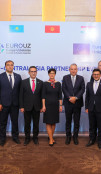Heritage on a plate: How EU support is helping to preserve Tarsus cuisine
St Paul and Cicero lived in Tarsus, where the spice-scent of sumac mixes with stories of past civilisations. Food gives memory and identity to the ancient city where women and young people continue to play an active role in keeping its culinary legacy alive.
EUROPEAN UNION, 2025
Aysel Koyuncu, hot meal chef
Aysel Koyuncu, whose life changed during a simple iftar meal, is one of the local women whose cooking helps nourish interest in the historic region.
“It was Ramadan. I invited Mr Ali Boltaç, who was a mayoral candidate at the time, to my home for iftar. I prepared a traditional Turkish meal. He enjoyed my cooking and said, ‘If I win, I’ll open a traditional culinary centre, and you’ll run the kitchen.’ He kept his promise. This is now my livelihood,” says Aysel.
She is now the hot meal chef at the vibrant Tarsus Gastronomy Centre, a community hub supported by the EU-funded SEECO (Social Entrepreneurship, Empowerment and Cohesion) project. The centre is in the historic Siptilli Bazaar and is managed by Tarsus Municipality’s Tarsus İmar Ltd.
EUROPEAN UNION, 2025
Orhun Çakır, former general manager of Tarsus İmar
“We built this centre to promote our culinary culture, boost tourism, and more importantly, create jobs for women and young people,” explains Orhun Çakır, former general manager of Tarsus İmar.
The centre employs 17 people, 10 of whom are women. Many of them, including İlayda Avcı, are trained chefs.
EUROPEAN UNION, 2025
İlayda Avcı, head of the kitchen team
“We have both formally trained and self-taught women working together. We learn from each other, and we see the power of women in action. Together, we rediscover the recipes that our grandmothers used to make in the villages or highlands,” she says.
EUROPEAN UNION, 2025
The most important feature of Tarsus kebab is that it contains both vegetables and minced lamb meat
Traditional Tarsus dishes
According to Mr Çakır, “Our centre offers a blend of Turkish, Arab and Kurdish cuisines. We serve dishes such as Tarsus kebab, lahmacun, hummus, and the iconic yüksük çorbası soup, reflecting the multicultural soul of our city”.
EUROPEAN UNION, 2025
Small lahmacun is a type of lahmacun unique to Tarsus
In the back kitchen, Ali Usta, the lahmacun master, prepares his signature dishes with care:
“We use minced lamb with onion and red pepper for fındık lahmacun. There’s the classic version, but also cheese, potato, spinach—even a tiny version called kuş gözü (bird’s eye).”
And across the workbench, Ali Usta, the hummus master, proudly shares a regional twist:
“Tarsus humus is served hot, as a main dish, not a meze. It’s made with well-cooked chickpeas and local tahini. We serve it with pickles and bread. Unlike the other dishes, you eat this one with a dessert spoon.”
EUROPEAN UNION, 2025
Bensu Çetin, a pastry chef, is making mamül biscuit
At the heart of the dessert team is Bensu Çetin, a pastry chef with a passion for local cuisine:
“For mamül biscuit, we use a dough with semolina, sugar, butter and hot (not boiling) water, then fill it with walnuts and press it into wooden moulds. It’s a tradition, but it’s also an art.”
Cultural continuity
The centre runs workshops on traditional recipes, helping to preserve the region’s culinary heritage.
“We had trouble finding young people who knew how to make these dishes,” says Çakır. “So now we pass on these skills through workshops. It’s not just about cooking; it’s about cultural continuity.”
EUROPEAN UNION, 2025
A workshop on making mamül biscuits
These free workshops are offered to the public, particularly women who want to learn how to cook traditional dishes.
“I already knew how to make stuffed meatballs, so I thought I might be able to learn how to make mamül biscuits, as their shape is similar before they are pressed into wooden moulds,” laughs Sakine Şimşek, who took part in a mamül workshop. “I applied, they called me, and I came.”
Zuhal Naz Çeken, another participant in the workshop, had been following the centre on Instagram.
“I was curious about local desserts and wanted to improve my skills. I also tried some of the dishes at the restaurant, and the flavours were amazing.”
EUROPEAN UNION, 2025
Perihan Taze, a regular visitor to the centre
Centre loved by locals
The project’s impact is deeply felt in the community. Perihan Taze, a regular visitor from the Tarsus Women’s Association, puts it simply:
“We come here often. I even bring friends who’ve never been. This place is a treasure for Tarsus. I thank those who contribute.”
Selin Oktay, another visitor, says: “I tried stuffed cabbage with tahini sauce—just like we make at home. Here, everything is clean, supervised, and well presented. It’s rare to find that outside.”
EUROPEAN UNION, 2025
The Acting Head of the Delegation of the European Union to Türkiye, Jurgis Vilčinskas
The EU’S angle
The Acting Head of the Delegation of the European Union to Türkiye, Jurgis Vilčinskas, says:
“Food carries the stories of a place — its history, people, and soul. In Tarsus, we see how a rich culinary heritage can become a source of pride and identity, as well as creating new opportunities. With the support of the EU, we are helping to preserve centuries-old traditions and empowering women and young people to build futures that are firmly grounded in culture. The Tarsus Gastronomy Centre is a shining example of how local heritage can inspire inclusive growth and social cohesion.”
To date, the SEECO project has incubated or accelerated over 1,650 enterprises and created almost 1,100 jobs. More than 18,000 people used the facilities and received support services. The EU-funded project is implemented by the Ministry of Industry and Technology in coordination with the World Bank.





